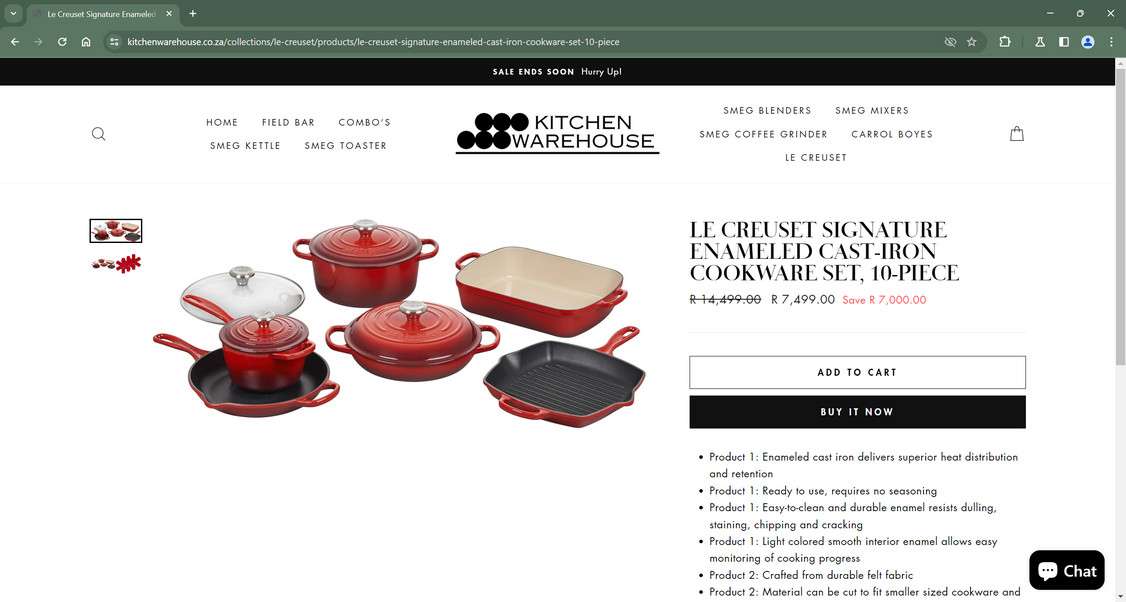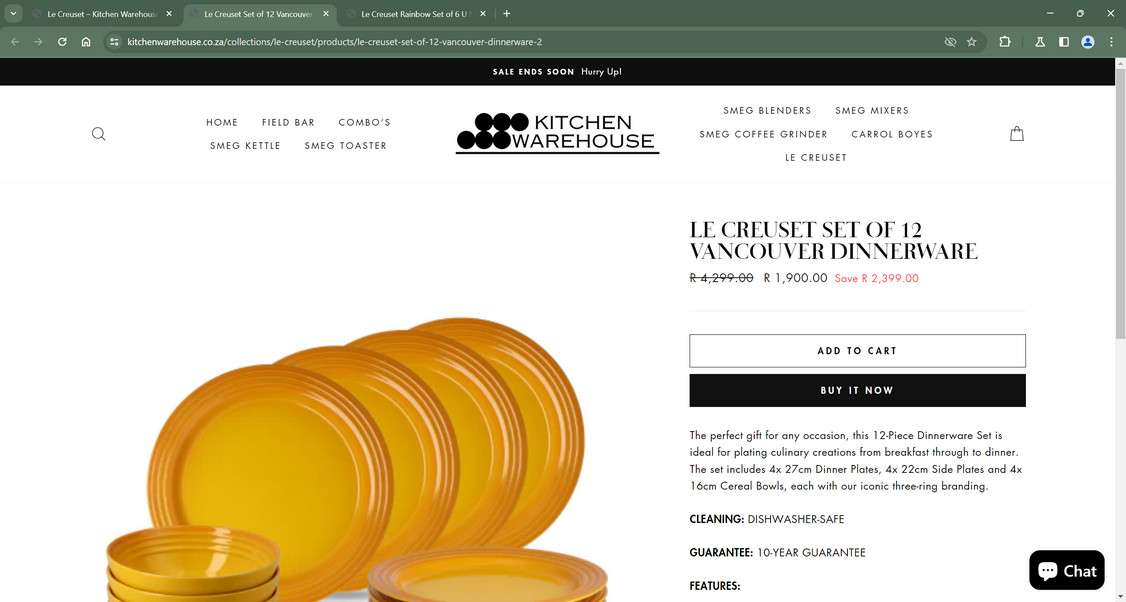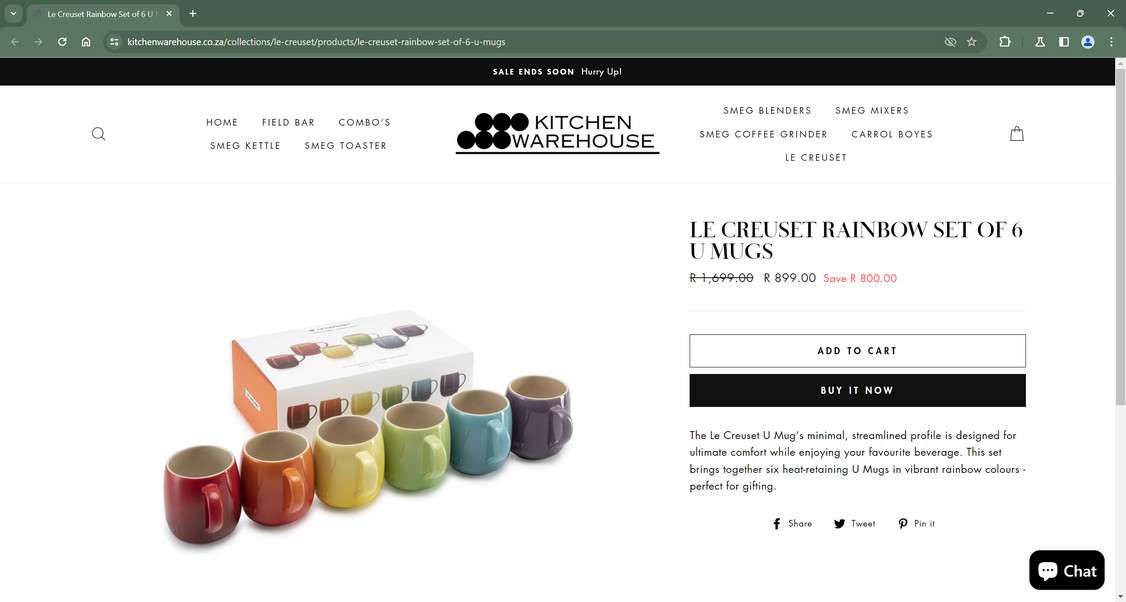Le Creuset is a premium French cookware brand known for colorful, enameled cast iron pots and pans. Unfortunately, scammers are exploiting Le Creuset’s reputation to trick customers into buying from fake website versions that offer deep discounts up to 90% off.
This scam heavily promotes clearance sales on social media platforms like Facebook and Instagram. The ads use the Le Creuset logo and product images to direct customers to fraudulent Le Creuset shopping websites. However, the deeply discounted items advertised simply do not exist – victims receive nothing after purchase or extremely low-quality counterfeits if anything.
This article provides an in-depth look at how the fake Le Creuset 90% off scam works, tips to spot fraudulent Le Creuset websites, what to do if you fell victim, and how to protect yourself from these too-good-to-be-true deals.



Overview of the Fake Le Creuset 90% Off Scam
This scam operates by creating fake e-commerce websites that mimic the look and feel of a legitimate Le Creuset online store. Scammers build sophisticated sites integrating Le Creuset’s official branding, logos, product catalogs, and overall premium aesthetic.
To attract customers, they run social media ads promoting “blowout” Le Creuset clearance sales with absurd discounts up to 90% off cast iron cookware, bakeware, tools and more. The posts portray unrealistic prices like $50 Dutch ovens originally $400 or $25 skillets marked down from $200.
If someone clicks an ad, they are directed to one of these scam websites masquerading as an authentic Le Creuset store and tempted to purchase products at incredible bargain prices. However, these fraudulent sites simply aim to steal money and personal information.
Victims receive nothing from these fake websites after purchase, or at best a cheap counterfeit item. The scam stores are quickly taken down once the crooks receive enough complaints. Then new sites reopen to keep the lucrative scam going.
This scam capitalizes on Le Creuset’s premium brand recognition and the temptation of steep discounts that seem too good to pass up. But there are ways to spot and avoid these fake websites.
How the Fraudulent Le Creuset Websites Operate
The fake sites appear impressively realistic on the surface but use deceptive tactics:
- Domain names – The urls seem like valid stores but contain small errors.
- Branding – Le Creuset logos, product images, and visual identity replicated throughout each site.
- Content – Product descriptions, policies, and other text lifted from real Le Creuset channels.
- Pricing – Items listed at implausibly low prices using pressure tactics and urgency.
- Checkout – Payment forms and processors appear legitimate but are set up to steal financial information.
While the sites look convincing thanks to Le Creuset’s stolen assets, inspecting closely exposes their fraudulent nature.
How the Fake Le Creuset Scam Unfolds:
Here is an in-depth look at how this scam operates from promotion to purchase:
1. Promote Fake Sales on Social Media
The scam starts with sponsored ads on platforms like Facebook, Instagram, and Google. The ads tout messages like “Le Creuset Sale! Up to 90% off” and “Going out of business clearance event!”.
Le Creuset products are shown next to implausibly low prices like $50, $100 or $150 instead of standard retail pricing. Urgency and scarcity tactics prompt immediate action.
2. Drive Traffic to a Sophisticated Fake Website
Clicking these social media ads directs users to an elaborate scam website convincingly designed to mimic a real Le Creuset online store.
The site integrates Le Creuset’s logos, fonts, visuals, and product catalogs into the layout. But small flaws like the URL reveal its fraudulent nature.
3. Lure Customers With Huge Discounts on Products
The fake Le Creuset site advertises extravagant 90% off discounts on cast iron cookware, bakeware, tools and more using urgency tactics to entice orders.
For example, a $400 Dutch oven is listed at $50 and a $200 skillet at $25. Countdown timers, limited quantities, and similar language aim to motivate quick checkouts.
4. Gather Customer and Payment Details During Checkout
If someone adds items to their cart, the site initiates a familiar checkout process collecting the standard order details – full name, shipping address, contact info, and crucially, payment information.
The payment options present well-known providers like Visa, PayPal, Apple Pay to build additional trust, although transactions only lead to stolen data.
5. Never Ship Any Products After Payment
Weeks later, victims who paid for deeply discounted products through these fake Le Creuset websites receive nothing in the mail.
The crooks take the money and shut down the site once enough people complain. A new scam site reopens to keep the scam going.
6. Steal Credit Card and Personal Information
Beyond just collecting payments for unsent orders, the scammers also obtain all personal and financial data entered during checkout on the site.
Names, addresses, credit card numbers, and other sensitive information is valuable on the black market and commonly used for identity theft. This makes avoiding these sites critical.
By mimicking Le Creuset’s web design and tempting shoppers with unrealistic discounts, these fraudsters trick those allured by the promise of deep clearance savings.
How to Spot Fake Le Creuset Websites – 8 Red Flags
With a discerning eye, you can detect the subtle but revealing characteristics that expose fraudulent Le Creuset shopping sites. Watch for these telltale signs that a website claiming to be a Le Creuset store is a scam:
1. Suspicious Domain Name
Inspect the url for oddities like misspellings, extra words added, or use of the wrong domain extension. LeCreuset.com is the only official site.
2. Missing Contact Information
There is no “Contact Us” page with a real physical address, customer service number, and other contact channels. Often only a dubious email is provided.
3. Implausibly Low Prices
Any discounts over 50% off are highly dubious. Be wary of prices like 90% off or $50 for a $400 Dutch oven. Le Creuset rarely offers over 40% off.
4. Familiar Looking Website Design
The layout, fonts, colors, navigation, and other elements mimic the real Le Creuset website to plagiarize the official shopping experience.
5. Fake Limited Time Messaging
Aggressive “Act Now!” messaging and countdown timers pressure buyers to purchase before scrutinizing the site more thoroughly.
6. Low-Quality Product Images
Image resolution on cookware, bakeware, and items appears inconsistent, heavily edited, or sloppy upon close inspection.
7. Generous Return Policy
Detailed return policy information with lenient terms Le Creuset does not offer. This falsely conveys legitimacy and trustworthiness.
8. Spelling and Grammar Issues
Numerous typos, poorly translated text, and other writing errors indicate an amateur scam operation.
Heightened awareness of these red flags helps identify fake Le Creuset sites attempting to lure in deal-seeking shoppers with unrealistic pricing and discounts. Always inspect closely and lean on skepticism before providing payment information or data.
How to Identify the Scam on Social Media
The fake Le Creuset sales are promoted via sponsored posts and ads on Facebook, Instagram, TikTok and other platforms. Here’s how to recognize them:
Spotting the Scam on Facebook
Watch for Facebook ads using:
- Huge discounts like “Le Creuset Outlet Sale! Cookware 90% off!”
- Countdown timers and limited quantity tactics urging immediate action
- Le Creuset logo and product images
- Links to odd domains instead of lecreuset.com
- Very little comments or reactions compared to the ad spend
Spotting the Scam on Instagram
Look for Instagram scam ads with:
- Unbelievable prices called out like “Pots just $50!”
- Captions with slogans like “Warehouse clearance!” and “Last day!”
- Le Creuset’s signature branding and cookware photos
- A disproportionately low number of likes and comments
- No authentic non-ad content on the account
Spotting the Scam on TikTok
Identify fake TikTok ads using:
- Videos promoting clearance sales with messaging like “Up to 90% off!”
- Urgency tactics in captions pressing viewers to click before a deadline
- Le Creuset logos, pots, pans, bakeware and other products
- Links in bios and captions that divert to shady domains
- Very generic comment responses indicating bots/fake accounts
Apply extra scrutiny to unbelievable discounts and sales events for major brands on social channels. Verify website legitimacy before clicking links or providing information.
Steps to Take if Scammed by a Fake Le Creuset Website
If you placed an order through one of these sophisticated fake Le Creuset retailer sites, immediately take these actions:
- Notify your credit card provider – Report the charges as fraudulent to initiate a chargeback and recover lost funds. Provide details about the scam site.
- Monitor accounts closely – Watch for any unauthorized charges indicating stolen financial information misuse. Enable real-time transaction alerts through account settings and your bank’s app.
- Place fraud alert on your credit – Contact one credit bureau to have an initial 90-day fraud alert placed on your credit file making opening new lines of credit harder.
- File complaints – Submit details on the scam site, lost money, and payment info used to the FBI’s Internet Crime Complaint Center and Federal Trade Commission to aid investigations.
- Warn others – Leave comments about the scam on social media ads leading people to fake sites. Report scam ads to platforms like Facebook and Instagram.
- Only dispute unreceived items – Some victims receive cheap counterfeits. Only dispute payment if you never got anything, since receiving an undesirable product still means you cannot falsely claim non-delivery.
Taking proactive measures limits damages from lost money to stolen identity information. Reporting also helps curb the scam’s success by exposing fraudulent websites impersonating Le Creuset stores.
How to Avoid Fake Le Creuset Online Sales Scams
Here are some tips and best practices to protect yourself from clearance sale scams:
- Only buy directly from LeCreuset.com – Never purchase through third parties. Stick to the official website for guaranteed authenticity.
- Research current products and pricing – If a deal seems too good to be true, double check against official Le Creuset listings.
- Avoid new, unfamiliar websites – Only trust established online retailers with long track records and numerous reviews.
- Read reviews and complaints – Research consumer experiences which often expose commonly scammed sites.
- Use credit cards for purchases – Never enter debit card or bank account information on lesser-known sites. Disputing credit charges is easier.
- Verify security seals – Ensure sites have https protocol and the padlock icon in the URL bar.
While tempting clearance sales reach out, apply extra scrutiny. Trust your instincts and verify legitimacy to avoid being scammed. Only purchase goods from authorized retailers at reasonable price points.
Frequently Asked Questions About the Fake Le Creuset Sales
Many people have questions about the fraudulent Le Creuset websites promoting huge clearance sales and discounts. Here are answers to some common FAQs about this retail scam:
Are the Le Creuset 90% off deals on Facebook real?
No. Any social media advertisements for Le Creuset clearance sales with discounts over 50% off are scams. Le Creuset rarely offers more than 40% off even during major sales events at its real stores.
How can I tell if a Le Creuset website is fake?
Inspect the URL for odd spellings, extra words added, or the wrong domain extension. Also look for contact info pages missing key details, prices far below normal retail value, and no links to Le Creuset’s social media accounts.
What happens if I order from a fake Le Creuset website?
You will likely receive nothing after payment, or at best a low-quality counterfeit item rather than the real enameled cast iron cookware shown. The scammers simply pocket your money and use any stolen financial information for fraud.
Can I get a refund if I purchase from a scam website?
If you paid by credit card you have a strong ability to dispute the charges as fraudulent and recover lost funds. Debit cards and wire transfers offer less purchase protection and recourse for obtaining refunds.
How do I report a fake Le Creuset website?
Contact Le Creuset directly to notify them of scam websites misusing their brand name and intellectual property without authorization. You can also file a complaint with the FBI’s Internet Crime Complaint Center.
Does Le Creuset have official outlet websites?
No. Le Creuset does not operate any official online outlet stores. Their real-life physical outlet locations do not sell goods directly through websites. Be very suspicious of any site claiming to be a Le Creuset online outlet store.
How can I avoid the fake Le Creuset scams?
Only purchase directly from LeCreuset.com or real Le Creuset brick and mortar retail locations. Never provide payment information to unfamiliar third-party websites, especially with unrealistic discount pricing. Use caution and verify legitimacy to avoid being scammed.
Apply heightened scrutiny to unbelievable deals from supposed Le Creuset websites. Verify site legitimacy directly with Le Creuset and trust your instincts to avoid clearance sale scams.
The Bottom Line
Le Creuset’s popularity and brand recognition have made it a target for elaborate fake ecommerce websites claiming to offer huge clearance discounts by impersonating Le Creuset stores. By mimicking Le Creuset’s web design and running social media ads with dramatic savings, they lure deal-seeking shoppers into relinquishing payment and personal information that is ultimately stolen.
However, telltale signs like unbelievable pricing, missing contact pages, and pressure tactics can expose fraudulent websites posing as legitimate retailers before major losses occur. Avoid falling victim to clearance sale scams by purchasing directly from official brand channels and being skeptical of discounts that seem too good to be true. Your caution is the best defense against these creative online shopping scams.










